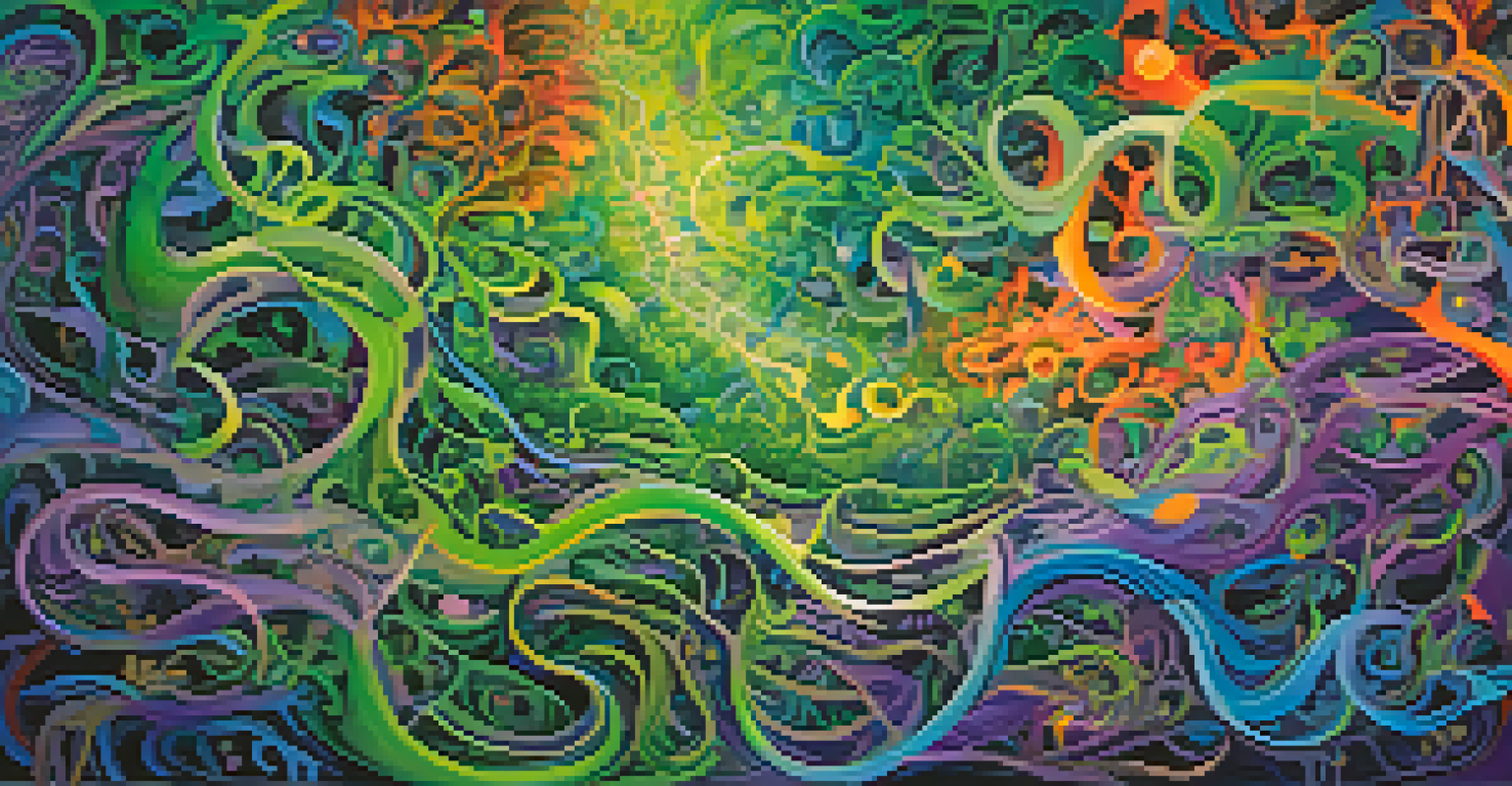Cultural Appropriation: Ayahuasca in Western Art Forms

Understanding Ayahuasca and Its Cultural Roots
Ayahuasca is a sacred plant medicine originating from the Amazon rainforest, traditionally used by indigenous tribes for spiritual healing and guidance. This brew, made from the Banisteriopsis caapi vine and other plants, is rich in cultural significance and has been utilized in rituals for centuries. It connects users to their ancestors and the natural world, offering profound insights and experiences.
Cultural appropriation is the act of taking or using elements from a culture that is not your own, especially without permission or understanding. It often results in the exploitation of that culture.
In indigenous cultures, Ayahuasca ceremonies are conducted with deep respect and understanding of the plant's power. Elders and shamans lead these rituals, ensuring that participants approach the experience with the right mindset. This cultural context is crucial; it shapes how Ayahuasca is perceived and experienced, emphasizing a communal and spiritual approach.
However, as Ayahuasca gains popularity in Western societies, its original meaning and context can be overshadowed. The allure of its psychedelic effects often leads to a commodification of the experience, stripping away the cultural significance that has been held for generations. Understanding this background is essential to grasp the nuances of cultural appropriation in Western art.
The Rise of Ayahuasca in Western Art Forms
In recent years, artists in the West have increasingly turned to Ayahuasca as a source of inspiration. From visual art to music and literature, many creators are drawn to the psychedelic experiences associated with the brew. This trend highlights a fascination with altered states of consciousness and the quest for deeper meaning in life.

However, this artistic exploration often raises questions about cultural appropriation. When Western artists incorporate Ayahuasca into their work, they may do so without fully understanding its cultural roots or the implications of their actions. This can lead to a distortion of the original significance, reducing a sacred practice to mere aesthetic inspiration.
Cultural Roots of Ayahuasca
Ayahuasca is a sacred plant medicine from the Amazon, deeply tied to indigenous rituals and spiritual healing.
As artists navigate their interpretations of Ayahuasca, it's vital for them to consider their role in this dialogue. Engaging with indigenous communities, respecting their traditions, and acknowledging the origins of their inspiration can help bridge the gap between cultures and foster a more respectful exchange.
Cultural Appropriation vs. Cultural Appreciation
The line between cultural appropriation and cultural appreciation can often be blurry, especially in the context of Ayahuasca in Western art. Cultural appropriation involves taking elements from a culture without understanding or respecting their significance, often leading to exploitation. In contrast, cultural appreciation acknowledges and honors the source culture, fostering a respectful exchange.
Art is a reflection of culture, and when artists engage with different cultures, they must do so with respect and understanding to avoid reducing rich traditions to mere aesthetics.
For example, an artist who uses Ayahuasca imagery in their work may do so with the intent to honor its beauty and significance. However, if they fail to engage with the culture or misrepresent its values, their work risks being seen as appropriative. Understanding the difference is crucial for artists who wish to explore these themes authentically.
To truly appreciate Ayahuasca and its cultural context, artists should aim to learn from indigenous voices. By collaborating with those who have a genuine connection to the plant and its traditions, they can create work that respects the origins while still expressing their own artistic vision.
Case Studies: Ayahuasca in Western Art
Numerous contemporary artists have woven Ayahuasca themes into their work, prompting discussions about cultural appropriation. For instance, some musicians incorporate the sounds or visuals associated with Ayahuasca ceremonies, creating a fusion of cultures. While these expressions can be compelling, they also risk oversimplifying a complex spiritual practice.
Visual artists may depict Ayahuasca-related imagery in ways that appeal to Western aesthetics, often straying from the original cultural meanings. This can lead to a commodification of the sacred, where the rich traditions associated with Ayahuasca are reduced to mere decoration. Such instances highlight the importance of understanding the cultural context behind the artwork.
Navigating Cultural Appropriation
Western artists must understand the cultural context of Ayahuasca to avoid misrepresenting its significance in their work.
Engaging with the stories and histories of Ayahuasca can add depth to artistic expressions. By grounding their work in research and respectful dialogue, artists can avoid the pitfalls of appropriation and instead contribute to a more nuanced conversation about cultural exchange.
The Role of Education in Understanding Ayahuasca
Education plays a vital role in fostering a deeper understanding of Ayahuasca and its cultural significance. Artists, scholars, and enthusiasts alike must seek to learn about the traditions surrounding the brew and the perspectives of indigenous communities. This foundation can help prevent misinterpretations and promote respectful engagement.
Workshops, documentaries, and books by indigenous authors can provide valuable insights into the Ayahuasca experience. By exploring these resources, individuals can gain a more comprehensive view of the rituals, beliefs, and practices associated with the plant. Such knowledge not only enriches artistic expression but also honors the cultural heritage from which Ayahuasca originates.
Furthermore, creating spaces for open dialogue between artists and indigenous communities can enhance understanding. Collaborations that prioritize cultural integrity over commercial gain can lead to genuine appreciation and enriched artistic narratives, ultimately benefiting both parties.
Ethical Considerations for Artists
As artists draw inspiration from Ayahuasca, they must navigate the ethical implications of their work. This includes reflecting on the potential impact of their creations on indigenous communities and the culture surrounding Ayahuasca. Responsible artists should consider whether their interpretations respect or exploit these traditions.
One approach is to involve indigenous voices in the artistic process. This can range from collaboration to consultation, ensuring that the perspectives of those directly connected to Ayahuasca are heard and valued. By doing so, artists can create work that is not only inspired by the culture but also contributes positively to it.
Importance of Ethical Engagement
Artists should involve indigenous voices in their creative process to ensure respectful and authentic representation of Ayahuasca.
Ultimately, ethical considerations should lead to a more mindful approach to creativity. By prioritizing respect and understanding, artists can create meaningful work that celebrates the richness of Ayahuasca while avoiding the pitfalls of cultural appropriation.
The Future of Ayahuasca Representation in Art
Looking ahead, the representation of Ayahuasca in Western art is likely to evolve as conversations about cultural appropriation continue to grow. Artists may increasingly seek to engage with indigenous cultures in a meaningful way, leading to richer and more authentic representations. This shift could help create a deeper understanding of Ayahuasca's significance beyond its psychedelic properties.
As audiences become more aware of the nuances of cultural exchange, they may also demand more ethically produced art. This could encourage artists to prioritize authenticity and respect, fostering a more inclusive environment where diverse voices are celebrated. Such a change could ultimately enrich the artistic landscape.

In this evolving context, both artists and audiences play a crucial role in shaping the narrative around Ayahuasca. By championing collaboration and cultural respect, the future of Ayahuasca representation in art can be one that honors its roots while also embracing new interpretations.